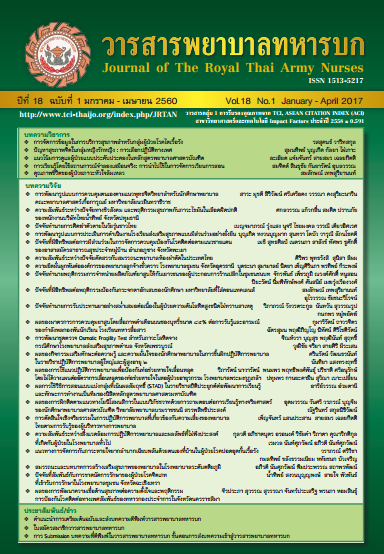แนวทางการจัดการกับภาวะหายใจยากลำบากเฉียบพลัน ด้วยตนเองที่บ้านในผู้ป่วยโรคปอดอุดกั้นเรื้อรัง
Keywords:
แนวทางการจัดการ, ภาวะหายใจยากลำบากเฉียบพลัน, โรคปอดอุดกั้นเรื้อรัง, Guideline for Management, Acute Exacerbation, Chronic Obstructive Pulmonary DiseaseAbstract
การศึกษาครั้งนี้เป็นการวิจัยเชิงคุณภาพ มีวัตถุประสงค์เพื่อวิเคราะห์แนวทางการจัดการกับภาวะหายใจยากลำบากเฉียบพลันด้วยตนเองที่บ้านตามการรับรู้ของผู้ป่วย และ ผู้ดูแล ผู้วิจัยได้เก็บรวบรวมข้อมูลโดยใช้การสังเกตแบบมีส่วนร่วมการสัมภาษณ์แบบเจาะลึก และ การศึกษาเอกสาร ผู้ให้ข้อมูล มีจำนวน 25 คน ประกอบด้วยผู้ให้ข้อมูลหลัก ได้แก่ ผู้ป่วยโรคปอดอุดกั้นเรื้อรังที่เป็นผู้ป่วยในคลินิกโรคถุงลมโป่งพองของโรงพยาบาลบางปะอิน จังหวัดพระนครศรีอยุธยา และ เคยเกิดภาวะหายใจยากลำบากเฉียบพลันจนต้องเข้ารับการรักษาที่โรงพยาบาล ในช่วงระยะเวลา 1 ปีที่ผ่านมา จำนวน 8 คน ผู้ให้ข้อมูลรอง ได้แก่ผู้ดูแล จำนวน 8 คน บุคลากรด้านสุขภาพจำนวน 9 คน เก็บข้อมูลระหว่างเดือนมีนาคม 2556 – ธันวาคม 2556 วิเคราะห์ข้อมูลด้วยการวิเคราะห์ เชิงเนื้อหาผลการศึกษาพบว่า แนวทางการจัดการกับภาวะหายใจยากลำบากเฉียบพลันด้วยตนเองที่บ้านในผู้ป่วยโรคปอดอุดกั้นเรื้อรังประกอบไปด้วย 4 ส่วน คือ 1) การรับรู้เกี่ยวกับโรคปอดอุดกั้นเรื้อรัง และภาวะหายใจยากลำบากเฉียบพลันของผู้ป่วย และผู้ดูแล ว่าเป็นโรคเรื้อรังที่เกิดจากปอดไม่ดี รักษา ไม่หายเป็นจนกระทั่งตาย ต้องกินยาตลอดชีวิต ซึ่งทำให้เกิดความทุกข์ทรมานต่อร่างกาย 2) ปัญหาและ ความต้องการในการจัดการกับภาวะหายใจยากลำบากเฉียบพลันที่บ้านของผู้ป่วย ผู้ดูแล พบว่า ผู้ป่วยส่วนใหญ่เป็นผู้สูงอายุ ต้องอยู่บ้านตามลำพัง จึงไม่มั่นใจในการดูแลตนเองเมื่อเกิดภาวะหายใจยากลำบากเฉียบพลัน ส่วนความต้องการพบว่า ผู้ป่วยต้องการผู้ดูแลใกล้ชิด ต้องการความรู้ ข้อมูลในการดูแลตนเองเมื่อเกิดภาวะหายใจยากลำบากเฉียบพลัน และ ต้องการให้บุคลากรด้านสุขภาพมาเยี่ยมบ้านบ่อยๆ 3) ปัจจัย หรือ เงื่อนไขที่มีผลต่อการจัดการกับภาวะหายใจยากลำบากเฉียบพลัน จากที่ผู้ป่วยเป็นผู้สูงอายุที่ร่างกายเสื่อมลงเรื่อยตามวัย และ มีโรคแทรกร่วมด้วย ประกอบกับมีผู้ดูแลเป็นครั้งคราว ทำให้เกิดความกลัว ความไม่มั่นใจในการจัดการกับภาวะหายใจยากลำบากเฉียบพลันด้วยตนเอง และ 4) แนวทางการจัดการกับภาวะหายใจยากลำบากเฉียบพลันด้วยตนเองที่บ้านของผู้ป่วย ผู้ดูแลประกอบด้วยการจัดการเมื่อเกิดอาการนำของภาวะหายใจยากลำบากเฉียบพลันโดยเน้นการดูแลตนเอง เช่น การดื่มน้ำอุ่น นั่งพัก การพ่นยา เป็นต้น เมื่อเกิดอาการหายใจยากลำบากเฉียบพลัน จะดูแลตนเองโดยการพ่นยา รับประทานยา ถ้าอาการไม่ดีขึ้นจะรีบมาโรงพยาบาลและการจัดการเพื่อป้องกันในระยะที่ยังไม่เกิดภาวะหายใจยากลำบากเฉียบพลันด้วยการทำสุขภาพให้แข็งแรง โดยการออกกำลังกายฝึกการหายใจ และหลีกเลี่ยงสิ่งกระตุ้น เป็นต้น
Guideline for Management the Acute Exacerbation at home by Chronic Obstructive Pulmonary Disease: COPD patient
This study is a qualitative research. The objective is to analyze guideline for management the acute exacerbation at home according to patient’s perception. Researchers gathered data using participate observation, in-depth interview and document analysis. 25 informants included keys informants are 8 of COPD patients who were treated acute exacerbation in emphysema clinic of Bang Pa In hospital, Ayutthaya province during the last 1 year. Another informant consists of 8 caregivers, 9 health care personnel. Data were collected during March 2013 – December 2013 and analyzed data using content analysis. The results have found that guideline for management the acute exacerbation at home by COPD patient consist of 4 sections. 1) Patient’s and caregiver’s perception of chronic obstructive pulmonary disease and acute exacerbation. That this is a chronic disease caused by lung illness, there is no 100% cure and need to be on medicine for the rest of their life which can be suffered. 2) Problems and needs for management the acute exacerbation at patient’s home. Have found that most of the patients are the elder and live alone then lack of confidence to look after oneself. For the needs, it have been found that , patients need a good care, knowledge for self care during acute exacerbation and also need to home visited by health care personnel more frequently. 3) Factors of conditions that affect management of the acute exacerbation consist of patient health conditions, patient unable to identified symptom and severity of acute exacerbation, lack of caregivers or too short of caregivers, transportation, fear and lack of confidence. 4) Guideline for management the acute exacerbation at home by COPD patients and caregivers effectively consist of managing during early stage of acute exacerbation, managing while acute exacerbation occur and managing for preventing during non-active phase.
Downloads
Downloads
How to Cite
Issue
Section
License
บทความหรือข้อคิดเห็นใดใดที่ปรากฏในวารสารพยาบาลทหารบกเป็นวรรณกรรมของผู้เขียน ซึ่งบรรณาธิการหรือสมาคมพยาบาลทหารบก ไม่จำเป็นต้องเห็นด้วย
บทความที่ได้รับการตีพิมพ์เป็นลิขสิทธิ์ของวารสารพยาบาลทหารบก
The ideas and opinions expressed in the Journal of The Royal Thai Army Nurses are those of the authors and not necessarily those
of the editor or Royal Thai Army Nurses Association.






